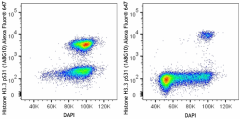- Clone
- 1A8G10 (See other available formats)
- Regulatory Status
- RUO
- Other Names
- Histone-H3
- Isotype
- Mouse IgG2b, κ
- Ave. Rating
- Submit a Review
- Product Citations
- publications

-

HeLa cells were incubated with (left) or without (right) nocodozole overnight, fixed with Fixation Buffer, permeabilized with True-Phos™ Perm Buffer then intracellularly stained with DAPI and Histone H3.3 Phospho (Ser31) (clone 1A8G10) Alexa Fluor® 647. -

HeLa cells were stimulated with (left) or without (right) nocodozole for 24 hours, fixed and permeabilized with cold 70% ethanol, then intracellularly stained with DAPI and Histone H3.3 Phospho (Ser31) (clone 1A8G10) Alexa Fluor® 647.
| Cat # | Size | Price | Quantity Check Availability | Save | ||
|---|---|---|---|---|---|---|
| 687703 | 25 tests | $206 | ||||
| 687704 | 100 tests | $452 | ||||
Histone 3, also known as H3, is a core component of the nucleosome that serves to wrap and compact DNA into chromatin. Histones therefore, limit the accessibility of DNA, providing mechanisms for transcription regulation, DNA repair and replication and chromosomal stability. H3 is part of the nucleosome, comprised of an octameric complex with H2A, H2B, and H4 proteins. H3 has been demonstrated to be phosphorylated by the action of MLTK-α (mixed linage kinase-like mitogen activated protein triple kinase α) in response to ultraviolet B light and epidermal growth factor, as well as Aurora-B during mitosis. Phosphorylation of H3.3 Ser31 occurs during mitosis and is a chromatin mark associated with heterochromatin. This phosphorylation coincides with chromosome condensation initiated at prophase and disappears at late anaphase.
Product DetailsProduct Details
- Verified Reactivity
- Human
- Antibody Type
- Monoclonal
- Host Species
- Mouse
- Immunogen
- Histone H3.3 S31ph peptide (24-37)(AARKSAP(phS)TGGVKK), Freund’s complete adjuvant.
- Formulation
- Phosphate-buffered solution, pH 7.2, containing 0.09% sodium azide and BSA (origin USA)
- Preparation
- The antibody was purified by affinity chromatography and conjugated with Alexa Fluor® 647 under optimal conditions.
- Concentration
- Lot-specific (to obtain lot-specific concentration and expiration, please enter the lot number in our Certificate of Analysis online tool.)
- Storage & Handling
- The antibody solution should be stored undiluted between 2°C and 8°C, and protected from prolonged exposure to light. Do not freeze.
- Application
-
ICFC - Quality tested
- Recommended Usage
-
Each lot of this antibody is quality control tested by intracellular immunofluorescent staining with flow cytometric analysis. For flow cytometric staining, the suggested use of this reagent is 5 µl per million cells in 100 µl staining volume or 5 µl per 100 µl of whole blood.
* Alexa Fluor® 647 has a maximum emission of 668 nm when it is excited at 633 nm / 635 nm.
Alexa Fluor® and Pacific Blue™ are trademarks of Life Technologies Corporation.
View full statement regarding label licenses - Excitation Laser
-
Red Laser (633 nm)
- Application Notes
-
Clone 1A8G10 detects histone H3.3 when phosphorylated at Ser31.
- RRID
-
AB_2629552 (BioLegend Cat. No. 687703)
AB_2629553 (BioLegend Cat. No. 687704)
Antigen Details
- Structure
- H3 is part of the nucleosome, comprised of an octameric complex with H2A, H2B, and H4 proteins.
- Distribution
-
Nucleus.
- Function
- H3 is a core component of the nucleosome that serves to wrap and compact DNA into chromatin. Histones therefore, limit the accessibility of DNA, providing mechanisms for transcription regulation, DNA repair and replication and chromosomal stability.
- Interaction
- Two molecules of H3 form a heterotetramer with two molecules of H4.
- Biology Area
- Cell Biology, Cell Cycle/DNA Replication, Cell Proliferation and Viability
- Molecular Family
- Phospho-Proteins
- Antigen References
-
1. Chang FT, et al. 2015. Nucleic Acids Res. 43:2603.
2. Sharma K, et al. 2014. Cell Rep. 8:1583.
3. Yoshimi T, et al. 2013. Monoclon. Antib. Immunodiagn. Immunother. 32:119. - Gene ID
- 3020 View all products for this Gene ID
- UniProt
- View information about Histone on UniProt.org
Related Pages & Pathways
Pages
Related FAQs
Other Formats
View All Histone Reagents Request Custom Conjugation| Description | Clone | Applications |
|---|---|---|
| Alexa Fluor® 647 anti-Histone H3.3 Phospho (Ser31) | 1A8G10 | ICFC |
Compare Data Across All Formats
This data display is provided for general comparisons between formats.
Your actual data may vary due to variations in samples, target cells, instruments and their settings, staining conditions, and other factors.
If you need assistance with selecting the best format contact our expert technical support team.
-
Alexa Fluor® 647 anti-Histone H3.3 Phospho (Ser31)

HeLa cells were incubated with (left) or without (right) noc... 
HeLa cells were stimulated with (left) or without (right) no...
 Login/Register
Login/Register 












Follow Us